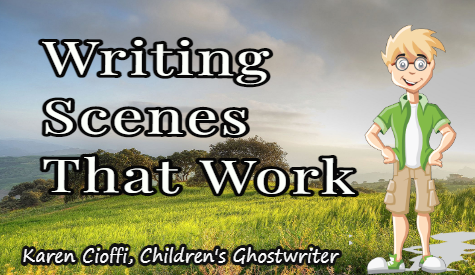One of the best descriptions I’ve read on what a scene is comes from James Scott Bell’s blog, Kill Zone. In an article on strengthening scenes, Bell explains that “scenes are the bricks that build the fiction house. The better the bricks, the better the house.” (1)
This gives a visual of how scenes work. Building one on top of the other to create a strong story.
Masterclass describes a scene as “a section of a story that has its own unique combination of setting, character, dialogue, and sphere of activity.” (2)
This description gives more details, but I like Bell’s visual better.
The Masterclass article also explains that scenes are one of the “most valuable writing skills an author can possess.”
This makes scenes even clearer. They’re essential to a ‘good’ book. Going back to the brick house, the better (stronger) the brick, the stronger the house.
A scene has a beginning, middle, and end, just like the story.
When the location changes, another character enters the scene, or something else significant changes within the scene, that’s usually an indication that it’s the end of that scene and the beginning of the next.
My middle-grade book, Walking Through Walls, is an example of this.
The protagonist, Wang, is trying to walk through a wall but just can’t do it. He’s fearful of getting hurt. It takes him ten tries.
Finally, he passes through it. That’s the end of that scene.
The next scene has Wang ecstatic. He’s thrilled. He can’t contain himself.
So, how do you make scenes work?
- The first thing a scene needs to do is achieve something.
Think of the brick. It’s solid. It’s its own entity.
Each scene has a story to tell.
The scene may be a chase scene, a fight scene, the inciting incident, a romantic scene, or a scene establishing the setting.
Using Walking Through Walls again, at the beginning of the story, Wang is seen sweating and complaining while working in the wheat fields. This scene establishes the type of work Wang is doing and also demonstrates his attitude toward it.
- A scene should be the foundation for the next scene.
Scenes are like building blocks. They provide information the reader should know to move forward in the story.
Going back to Wang and his attitude toward hard work, it allows the reader to understand why he desperately wants a way out of his life.
The scene can also provide more information, such as backstory, or a look into the character’s family life, friendships, strengths, weaknesses, and so on.
It can be anything of value that helps move the story and characters forward.
- Every scene should have a point of view.
As a children’s ghostwriter, the majority of the stories I write have one point of view.
But I also work on upper middle grade where there can be two points of view and young adult where there can be multiple points of view.
When working with more than one point of view, each scene should be specific to only one; otherwise, it can get confusing and weaken the strength of that brick.
- Each scene should contribute to the world you’re creating.
The period of Walking Through Walls is 16th century China. This meant a lot of research.
I incorporated tools of the period, clothing, and even food within the scenes to build the world the characters lived in.
I also used dialogue to build the world. I eliminated contractions and flavored the dialogue and actions with respect, especially toward elders.
- As your story should be shown and not told, so should your scenes.
It doesn’t matter whether you’re a new writer or an experienced writer; it’s easy to fall into the ‘telling’ mode when writing.
Showing a scene means using dialogue, action, sensory details, and internal thoughts.
Using showing enables the reader to be absorbed in the story. It connects the reader to the character and brings the reader into the story.
Telling keeps the reader at arms-length. The reader won’t be able to make as strong a connection to the character or the story.
Hope these five tips on writing a good scene help you strengthen your own story’s scenes.
References
(1) https://killzoneblog.com/2021/08/three-easy-ways-to-strengthen-a-scene.html
(2) https://www.masterclass.com/articles/how-to-write-the-perfect-scene#quiz-0

I’m a working children’s ghostwriter, rewriter, editor, and coach. I can help turn your story into a book you’ll be proud to be the author of, one that’s publishable and marketable.
OTHER HELP I OFFER:
HOW TO WRITE A CHILDREN’S FICTION BOOK
A DIY book to help you write your own children’s book.
PICTURE BOOK AND CHAPTER BOOK COACHING
Four to ten-week coaching programs.
WRITERS ON THE MOVE SELF-PUBLISHING HELP.
Self-publishing help for children’s authors.
Creating An Author Online Platform
Step-by-step with a former WOW! Women on Writing author online platform instructor
You can contact me at: kcioffiventrice@gmail.com. Or give me a call at 347—834—6700. (Please leave a message- I’ll get back to you as soon as I can.)
Traditional Publishing and Self-Publishing – The Differences
6 Power-Tips to Writing a Memorable Protagonist for Your Children’s Story
Secondary Characters – Are They Important?


